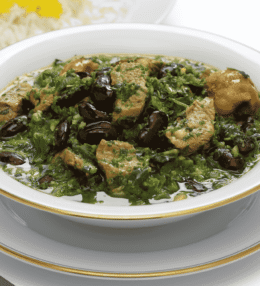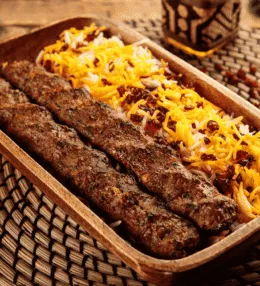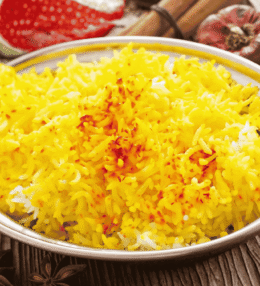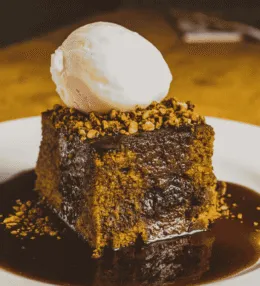
- View
Table of Contents
ToggleDevilled kidneys belong to the bold breakfast tradition of Britain, a dish that wakes the palate with heat and savour. Quick to cook and satisfying to eat, it sets rich kidneys against a lively sauce of mustard, cayenne and Worcestershire. Served on buttered toast, it delivers comfort with a kick.
What appeals is the lively balance. The meat is tender with a faint mineral sweetness, the sauce is fiery yet rounded, and the toast brings a pleasing crunch. You can eat it at daybreak, but it suits a late supper just as well, especially beside a glass of something sturdy.
It is a dish that rewards care, not fuss. A brief soak and a swift sear keep the texture soft, while the sauce comes together in the same pan. In less than ten minutes you move from prep to plate. That speed, along with the sheer flavour, explains its loyal place on British menus.
Want to dive deeper into British Cuisine? Don’t miss our post on Traditional British Foods to Try
What are Devilled Kidneys?
At its heart sit lamb kidneys, trimmed and quickly seared, then tossed in a spiced pan sauce. Mustard gives drive, cayenne supplies heat, and Worcestershire brings savoury depth. A splash of stock or stout rounds it out, and butter smooths the edges. The result is glossy, hot and inviting.
Frugality shaped the recipe. Offal was once a routine buy at the butcher, prized for flavour and value. Devilling used pantry seasonings to lift humble cuts, turning them into dishes with real verve. Today the appeal continues, because the same cupboard staples create something vivid without strain or waste.
Portions are small but satisfying. Think two to three kidneys per person, sliced and cooked until just blushing within. The sauce clings lightly rather than drowning the meat. Pile it on toast or spoon it with mash and greens. Either way, you get a plate that feels generous and spirited.
Ingredients and Taste
The ingredient list is compact. You need fresh lamb kidneys, English mustard, cayenne or chilli powder, flour for a light dusting, butter, a little oil, Worcestershire sauce, shallot or onion, beef stock or a dash of stout, parsley, salt and black pepper. Lemon at the end adds needed brightness.
Flavour skews hearty and lively. The kidneys bring a gentle iron note and a delicate snap, the sauce brings heat, smoke and umami. Mustard cuts through richness, cayenne pricks the tongue, Worcestershire adds depth, and lemon keeps everything alert. Toast soaks up juices and gives a welcome crunch.
Quality matters. Choose firm, shiny kidneys with a clean scent and trim the white core before cooking. A short soak in milk or lightly salted water softens stronger notes. Dry thoroughly, dust with flour for colour, and sear quickly in a hot pan. Overcooking turns them grainy, so be swift.
A Taste of History
Devilled dishes emerged during the 18th century in Britain, when ‘devilling’ referred to cooking food with hot spices and sharp condiments. The technique became particularly fashionable during the Victorian era.
Gentlemen’s clubs in London served devilled bones, kidneys and other leftovers as late night suppers after theatre or cards. These spicy preparations were thought to aid digestion after heavy drinking and rich dinners.
Kidneys themselves held an important place in British cooking long before the devilling trend arrived. As an affordable source of protein, offal appeared regularly on tables across all social classes.
Wealthy households might serve elaborate kidney preparations at breakfast, whilst working families stretched their budgets by incorporating cheaper cuts and organ meats into daily meals. The Victorian and Edwardian breakfast tables particularly celebrated devilled kidneys.
Post-war Britain saw a gradual decline in offal consumption as prosperity increased and people could afford to be choosier about their protein sources. Devilled kidneys became associated with old fashioned hotel breakfasts and traditional restaurants.
Yet the dish persists, kept alive by chefs and food enthusiasts who recognise its place in British culinary heritage and appreciate the depth of flavour that organ meats bring to the table when treated with proper skill and respect.
How to Make Devilled Kidneys
Devilled kidneys are a true British breakfast classic, full of bold, peppery warmth balanced with a touch of tang from Worcestershire sauce and mustard. The dish is hearty, quick to prepare, and traditionally enjoyed on toast for a richly flavoured start to the day. See the recipe card at the bottom for printable directions
Ingredients
- 8 lamb kidneys, cleaned and halved (remove the white core)
- 25 g plain flour
- 1 tsp English mustard powder
- 1 tsp cayenne pepper (adjust to taste)
- Salt and freshly ground black pepper, to taste
- 25 g unsalted butter
- 1 tbsp vegetable oil
- 1 small shallot, finely chopped
- 1 tsp Worcestershire sauce
- 1 tsp Dijon mustard
- 1 tsp tomato purée
- 100 ml beef stock
- 1 tbsp double cream (optional, for richness)
- Fresh parsley, finely chopped (for garnish)
- 4 slices of toasted crusty bread, to serve
Cooking Instructions
Step 1: Prepare the kidneys
Begin by trimming and halving the lamb kidneys. Remove any membrane and the white fatty core, as these can cause bitterness. Pat dry with kitchen paper to ensure even browning.
Step 2: Season and coat
In a shallow dish, combine the flour, mustard powder, cayenne, salt, and black pepper. Toss the kidneys in this seasoned flour until evenly coated. Shake off any excess and set aside while you heat the pan.
Step 3: Sauté the shallots
Heat the butter and oil together in a large frying pan over medium heat. Once the butter foams, add the chopped shallot and cook gently until softened and translucent. This forms the aromatic base of the sauce.
Step 4: Brown the kidneys
Increase the heat slightly and add the floured kidneys to the pan. Sauté for about 2 minutes on each side until golden brown but still tender within. Avoid overcooking, as kidneys can become tough.
Step 5: Prepare the sauce base
Remove the kidneys from the pan and set aside on a warm plate. Add Worcestershire sauce, Dijon mustard, and tomato purée to the pan juices. Stir briskly to loosen any browned bits stuck to the bottom of the pan.
Step 6: Add stock and simmer
Pour in the beef stock and stir to combine. Simmer for 3 to 4 minutes until the sauce thickens slightly and becomes glossy. Taste and adjust seasoning if needed, balancing the spice and tang.
Step 7: Return kidneys to the pan
Return the kidneys to the sauce, coating them well. Cook gently for 1 to 2 minutes to heat through. If desired, stir in a splash of double cream for a smoother finish.
Step 8: Prepare the toast
While the kidneys finish, toast thick slices of crusty bread until golden and crisp. Butter them lightly to help soak up the rich sauce.
Step 9: Assemble and garnish
Spoon the devilled kidneys over the toast and drizzle with any remaining sauce. Scatter freshly chopped parsley on top for a burst of freshness.
Step 10: Serve immediately
Serve hot for breakfast or brunch. The dish pairs wonderfully with grilled tomatoes or sautéed mushrooms for a full English style plate.
Variations and Substitutions
- Meat alternative: Calves’ kidneys or chicken livers can replace lamb kidneys for a milder flavour.
- Mustard: English mustard gives the best kick, but Dijon or wholegrain can be used for a softer taste.
- Stock: Vegetable stock works if beef stock is unavailable, though it gives a lighter flavour.
- Spice level: Reduce the cayenne for a gentler dish or add a pinch of smoked paprika for depth.
Cooking Tips for Perfect Devilled Kidneys
- Always trim kidneys thoroughly to avoid bitterness.
- Cook kidneys quickly over medium to high heat to keep them tender.
- Let the sauce reduce until it clings to the back of a spoon for ideal consistency.
- Serve immediately, as kidneys can toughen if reheated.
- Use a cast iron or heavy bottomed pan for even heat distribution.

Devilled Kidneys (Spiced Lamb Kidneys)
Ingredients
- 8 lamb kidneys cleaned and halved (remove the white core)
- 25 g plain flour
- 1 tsp English mustard powder
- 1 tsp cayenne pepper adjust to taste
- Salt and freshly ground black pepper to taste
- 25 g unsalted butter
- 1 tbsp vegetable oil
- 1 small shallot finely chopped
- 1 tsp Worcestershire sauce
- 1 tsp Dijon mustard
- 1 tsp tomato purée
- 100 ml beef stock
- 1 tbsp double cream optional, for richness
- Fresh parsley finely chopped (for garnish)
- 4 slices of toasted crusty bread to serve
Instructions
- Begin by trimming and halving the lamb kidneys. Remove any membrane and the white fatty core, as these can cause bitterness. Pat dry with kitchen paper to ensure even browning.
- In a shallow dish, combine the flour, mustard powder, cayenne, salt, and black pepper. Toss the kidneys in this seasoned flour until evenly coated. Shake off any excess and set aside while you heat the pan.
- Heat the butter and oil together in a large frying pan over medium heat. Once the butter foams, add the chopped shallot and cook gently until softened and translucent. This forms the aromatic base of the sauce.
- Increase the heat slightly and add the floured kidneys to the pan. Sauté for about 2 minutes on each side until golden brown but still tender within. Avoid overcooking, as kidneys can become tough.
- Remove the kidneys from the pan and set aside on a warm plate. Add Worcestershire sauce, Dijon mustard, and tomato purée to the pan juices. Stir briskly to loosen any browned bits stuck to the bottom of the pan.
- Pour in the beef stock and stir to combine. Simmer for 3 to 4 minutes until the sauce thickens slightly and becomes glossy. Taste and adjust seasoning if needed, balancing the spice and tang.
- Return the kidneys to the sauce, coating them well. Cook gently for 1 to 2 minutes to heat through. If desired, stir in a splash of double cream for a smoother finish.
- While the kidneys finish, toast thick slices of crusty bread until golden and crisp. Butter them lightly to help soak up the rich sauce.
- Spoon the devilled kidneys over the toast and drizzle with any remaining sauce. Scatter freshly chopped parsley on top for a burst of freshness.
- Serve hot for breakfast or brunch. The dish pairs wonderfully with grilled tomatoes or sautéed mushrooms for a full English style plate.
Nutrition
You May Also Like







Leave a Review